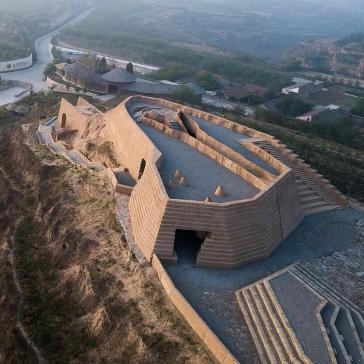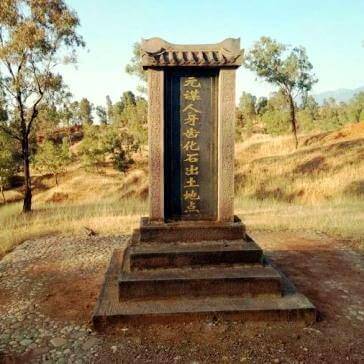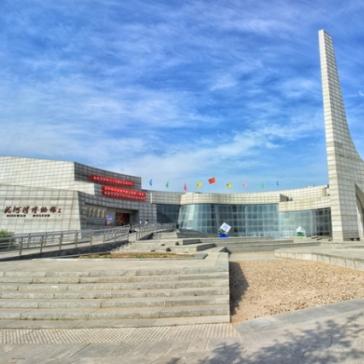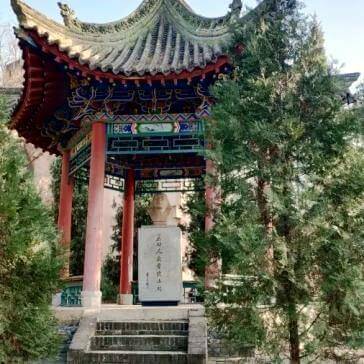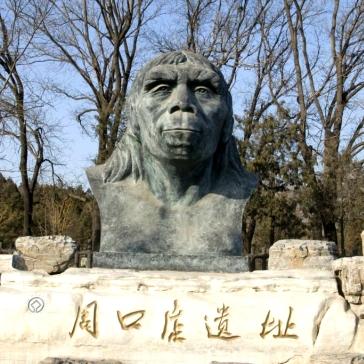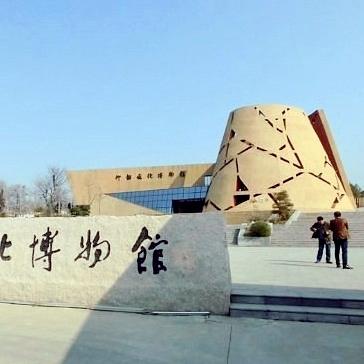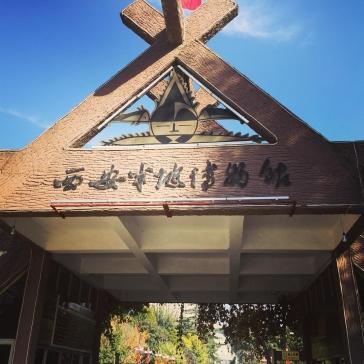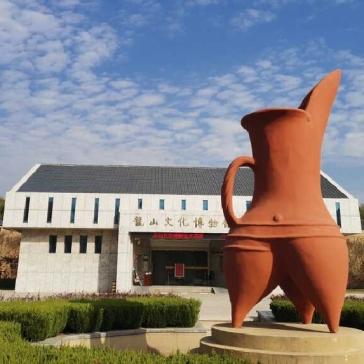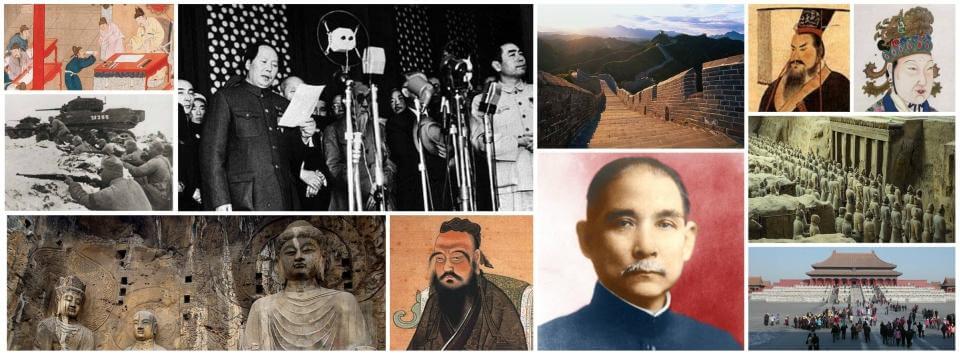
Prehistory
Paleolithic Period
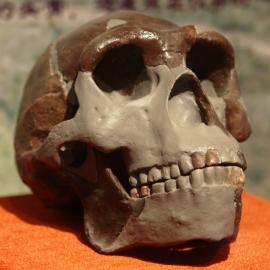 replica of the Peking Man SkullSeveral places of early hominid habitation (inhabited by Homo erectus, the predecessor of modern humans) have been discovered in China so far, some of which have achieved a certain fame.
replica of the Peking Man SkullSeveral places of early hominid habitation (inhabited by Homo erectus, the predecessor of modern humans) have been discovered in China so far, some of which have achieved a certain fame.
The oldest paleolithic site on Chinese territory that is known today was discovered near Xihoudu village in Ruicheng County (Shanxi Province). At the Xihoudu Site, prehistoric animal bones were found that have scorch marks on them. This archeological evidence was at first carbon-dated to be about 1.8 million years old. According to more recent analysis through carbon-14 dating, these relics that prove the use of fire by Homo erectus may even be more than 2.4 million years old. The use of fire is commonly regarded as the key factor that distinguishes human beings from animals. Since the relics that were found at the Xihoudu Site constitute evidence for the earliest recorded use of fire in the world, this remote place can therefore be considered the birthplace of human civilization. Furthermore, excavations that were made at the Xihoudu Site in the 1960s also unearthed some primitive stone tools which may (if genuinely man-made and not natural in origin) be the world's oldest man-made tools.
Most travelers that nowadays come to visit the prehistoric Xihoudu Site due to its importance as the cradle of human civilization do so on a day trip from the city of Xi'an which lies about a two-hour drive of roughly 140km to the west. A museum was built at the site in 2013 where many of the discovered relics are displayed. A few years ago, the architecture firm Urbanus transformed the look of the hilltop terrace where the site is located by building viewing platforms and a uniquely-designed mountaintop experience exhibition hall there. Since then, the site is also known as "Holy Fire Lit Place".
Xihoudu Site (Holy Fire Lit Place)
The Xihoudu Site is regarded as the world's earliest site for the human use of fire. The stone objects that were excavated at the site may also be the world's oldest man-made tools. The ancient hilltop terrace where this archeological site was excavated is nowadays also known as Holy Fire Lit Place. Many of the prehistoric relics that were unearthed at the site in 1961, 1962 and 2005 are now on display inside a museum there.
Click here to learn more!Opening Hours
8am - 6pm
Entrance Ticket Prices
20 yuan
Whereas we only know about the humanoid ancestors that lived millions of years ago at and near the Xihoudu Site through evidence of their activities, there were other humanoid subspecies of Homo erectus that once inhabited this part of the Asian continent of which actual fossils were discovered. Among the fossils of ancient ape-like humans that were discovered in China so far, it is the fossils of Yuanmou Man that were unearthed at the Yuanmou Man Site in 1965 (2 incisor teeth) and 1984 (a shinbone) that are the oldest. Paleomagnetic dating of the two incisor teeth has revealed them to be about 1.63 to 1.64 million years old.
Even though there is not that much to see at the Yuanmou Man Site these days, its natural setting near Danawu Village in Yuanmou County (Yunnan province) makes a short visit nevertheless worthwhile for those tourists that make it to this relatively remote part of southern China. The best place to learn more about Yuanmou Man's place in the human evolutionary chain is the modern Yuanmou Man Museum which is located in Yuanma Town (the administrative center of Yuanmou County), just a few kilometers away from the Yuanmou Man Site.
Yuanmou Man Museum & Site
The Yuanmou Man Site is the archeological site where the oldest fossils of ancient humans were discovered on Chinese territory. Whereas the first excavation on the 1st of May 1965 uncovered 2 incisor teeth, a later excavation in 1984 unearthed a shinbone. The modern Yuanmou Man Museum that was built nearby displays thousands of ancient relics (including animal fossils and ancient stone tools) and models (including a large model of a dinosaur fossil).
Click here to learn more!Opening Hours
9am - 5pm
Entrance Ticket Prices
Free Admission
There is a strong possibility that fossils of ancient humans that are much older than those of Yuanmou Man will eventually be found in China, most likely in the 60-kilometer-long and 10-kilometer-wide Nihewan Basin in Yangyuan County (Hebei province). During prehistoric times, this basin was filled by a vast lake that gradually dried up and left behind a thick layer of sediment deposits. Archeological excavations of these sediment deposits have uncovered animal fossils as well as stone and bone tools that were made by ancient humans. Many of the discovered stone artifacts were found in sediments that are more than a million years old, for example at the Xiaochangliang Site (1.36 million years old), Goudi Site (1.66 million years old) and Heitugou Site (almost 2 million years old).
The government of Yangyuan County has invested millions of yuan during the last decade in order to improve the county's tourism infrastructure. Whereas the Nihewan National Nature Reserve attracts tourists due to its distinctive scenery, the Nihewan Museum in the municipality of Yangyuan is the place where the relics that were unearthed from the various Nihewan Ruins are exhibited.
Nihewan Ruins and Museum
There are 156 prehistoric relic sites in the Nihewan Basin which are known as the Nihewan Ruins. Most relic sights are located within the Nihewan National Nature Reserve. Tourists can explore this cradle of evolution on elevated wooden walkways without disturbing the sediment deposits underneath. About 50,000 of the relics that were unearthed within the basin are on display at the modern Nihewan Museum. That makes it the largest museum for prehistoric relics in China!
Click here to learn more!Opening Hours
9am - 5pm
closed on Monday and Friday
Entrance Ticket Prices
Free
Tickets only available until 3.30pm!
Further hominid remains were found in Lantian County southeast of Xi'an in the 1960s. Whereas the 500,000 to 650,000-years-old mandible of an older female was the only humanoid fossil that was discovered at the Chenjiawo Site (see page 138 of linked pdf) there in September 1963, further excavations at the nearby Gongwangling Site in May 1964 were much more successful. The Homo erectus cranium that was found there alongside nasal bones, a right maxilla and three molars is now believed to be somewhere between 1.62 and 1.63 million years old.
About 200 exhibits that are related to this discovery of prehistoric Lantian Man are now on display at the Lantian Yuanren Site Memorial Museum. This museum is the main attraction of the Lantian Yuanren Relic Site which was opened as a tourist attraction at the location of the Gongwangling Site.
Lantian Yuanren Relic Site
The Lantian Yuanren Relic Site is located in Lantian County about 50km to the southeast of Xi'an. It includes the Lantian Yuanren Site Memorial Museum which was opened in 2012. The museum's exhibits are made up of human and animal fossils as well as prehistoric stone artifacts such as scrapers and choppers. There is also a garden leisure area at the site that has a traditional Chinese stele pavilion with a bust that recreates Lantian Man's appearance.
Click here to learn more!Opening Hours
Tuesday - Sunday: 9am - 4.30pm
Entrance Ticket Prices
Free
The remains of Peking Man (680,000 - 780,000 years old) that were found in a cave near Zhoukoudian (near Beijing) are however by far the most famous hominid remains ever found in China. These hominid ancestors who were physically distinguished by a heavy brow ridge and large teeth already used fire and stone tools and had an erect posture. Many other questions (were they cannibals?) remain unanswered until this day, also due to the fact that the original remains were mysteriously lost in 1941 during World War II and may never be rediscovered. Destined for safekeeping in the United States, the fossils are presumed to have vanished en route to the port city of Qinhuangdao.
Peking Man Site
The world-famous Peking Man Site and its attached Peking Man Museum are located about 42km southwest of Beijing at Zhoukoudian in Fangshan County. Peking Man (Homo erectus pekinensis) is the name that was given to the ancient Homo erectus hominids that are estimated to have lived at the Zhoukoudian site during prehistoric times as far back as about 700,000 years ago.
Click here to learn more!Opening Hours
April - October: 8.30am - 4.30pm
November - March: 9am - 4pm
Peking Man Museum is closed on Mondays
Entrance Ticket Prices
30 yuan
Peking Man Museum: + 30 yuan
Tickets sold until 30 min before closing time
Based on fairly recent findings, Homo sapiens appeared on the scene of what is now China about 100,000 years ago. A series of primitive hunting and gathering civilizations appeared all across this part of Asia that began to use more and more sophisticated stone tools.
Neolithic Period
 Neolithic stone sickle, Peiligang Culture, National Museum of China, Beijing.About 12,000 years ago, during a period that we now call the Neolithic Transition, the domestication of grain (and particularly rice) established village cultures and therefore created a settled agricultural society (whereas previously people were hunters and gatherers). Early societies appeared all over the territory that is now China during the neolithic period. What distinguishes the neolithic from the paleolithic period is the beginning of plant cultivation, animal husbandry and pottery making.
Neolithic stone sickle, Peiligang Culture, National Museum of China, Beijing.About 12,000 years ago, during a period that we now call the Neolithic Transition, the domestication of grain (and particularly rice) established village cultures and therefore created a settled agricultural society (whereas previously people were hunters and gatherers). Early societies appeared all over the territory that is now China during the neolithic period. What distinguishes the neolithic from the paleolithic period is the beginning of plant cultivation, animal husbandry and pottery making.
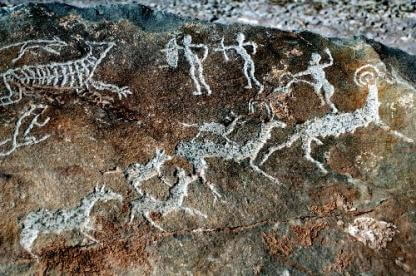 Damaidi rock carvingsOne of these early societies has left its mark in a fairly remote area that is now the Ningxia Hui Autonomous Region where 3,172 cliff carvings, featuring 8,453 individual figures (e.g. sun, moon, stars, gods, scenes of hunting or grazing) were discovered in the late 1980s near the small village of Damaidi (Zhongwei County). You can see the location of the Damaidi village on this Google map.
Damaidi rock carvingsOne of these early societies has left its mark in a fairly remote area that is now the Ningxia Hui Autonomous Region where 3,172 cliff carvings, featuring 8,453 individual figures (e.g. sun, moon, stars, gods, scenes of hunting or grazing) were discovered in the late 1980s near the small village of Damaidi (Zhongwei County). You can see the location of the Damaidi village on this Google map.
Some of the engraved pictographs bear a strong resemblance to the ancient forms of written Chinese characters. The age of the carvings is still disputed. Whereas the carvings were at first estimated to be between 7,000 and 8,000 years old, some cliff painting experts now believe that they are actually 16,000 to 10,000 years old. Since the carvings are in either case much older than the oracle bone inscriptions of the Shang dynasty, they might represent the origins of the Chinese writing system.
Another culture that left its mark in early Chinese history is the Peiligang culture (7000 BC - 5000 BC). The Peiligang people may have been the first ones that lived in constructed buildings instead of caves. They cultivated millet and raised pigs, cattle and poultry while continuing to hunt and fish.
The Peiligang culture got its name from the Peiligang Site which was discovered in 1977 at Peiligang village in Henan province. The local government may eventually attempt to develop this Peiligang Ruins Site into a tourist attraction, but there is hardly anything to see there now that would merit a visit. More than 100 sites that are associated with the Peiligang culture have since been identified within an area of only about 100 square kilometers.
The Jiahu Site is another famous site that has commonly been associated with the Peiligang culture, even though it is located more than 100km away from the Peiligang Site. The Jiahu people that inhabited this site may have been the inventors of music in this part of Asia. That is because the prehistoric bone flutes that were excavated at the Jiahu Site are currently the oldest musical instruments that were discovered in China. These days, the local Chinese government has quite ambitious plans to turn the Jiahu Ruins Site at its remote location into an archeological park that attracts tourists.
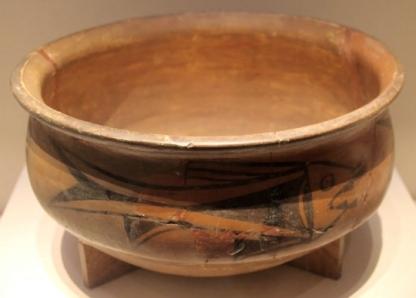 Painted earthenware basin with fish design, Yangshao Culture (excavated at Banpo Site in Xi'an)It is hotly debated when rice was first domesticized (some scientists even believe that millet was cultivated first) and estimates seem to range from about 11,000 BC to 4000 BC. What is clear though is that the emergence of rice farming played a major role in the transformation from a nomadic hunting and gathering culture to a culture of more and more permanent settlements/villages.
Painted earthenware basin with fish design, Yangshao Culture (excavated at Banpo Site in Xi'an)It is hotly debated when rice was first domesticized (some scientists even believe that millet was cultivated first) and estimates seem to range from about 11,000 BC to 4000 BC. What is clear though is that the emergence of rice farming played a major role in the transformation from a nomadic hunting and gathering culture to a culture of more and more permanent settlements/villages.
Many early civilizations in the area that is now China settled in the Yellow River Valley but neolithic cultures appeared elsewhere too. You can see a list of all the currently known neolithic cultures of China on this page. All these early civilizations can be distinguished through the pottery that they made. The four possibly most significant (based on archeological discoveries until now) cultures that appeared in China about 6,000 or 7,000 years ago were the Yangshao culture, the Longshan culture, the Liangzhu culture and the Daxi culture.
The Yangshao culture existed from around 5000 BC until about 3000 BC. Its people settled in villages in the area around the middle reaches of the Yellow River. The majority of the more than 1,000 Yangshao culture sites that have so far been identified are located in the provinces of Henan, Shaanxi and Shanxi.
The culture is also known as Painted Pottery Culture. Most Yangshao pottery is colored a pale yellow-brown. Drawings of animals (especially fish) or geometric patterns were most often used as a form of decoration. Despite its elaborate design, Yangshao pottery is usually quite heavy.
The first site of this culture was discovered near Yangshao village in Henan. That's what gave the Yangshao culture its name. The first excavation of the Yangshao Site was led by the Swedish archeologist Johan Gunnar Andersson who had already found prominence a few years earlier due to his discovery of the world-famous Peking Man Site at Zhoukoudian.
The Yangshao Site merits a visit even though it is neither the biggest nor the most visited Yangshao Culture site. There are two main reasons for this recommendation. The first reason is the fairly recent conversion of the site into a beautifully-landscaped archeology park. The actual excavation zone can be seen inside this park. The second reason is the Yangshao Culture Museum which was built right next to the site. This modern museum has the largest number of Yangshao pottery exhibits, each one of them totally unique in its design!
Yangshao Site & Culture Museum
The Yangshao Site is located inside the Yangshao Village National Archaeological Park about 9km north of Mianchi County (Henan province). It was the first Yangshao culture site that was discovered in 1920. The Yangshao Culture Museum opened its doors to the public in 2011 right next to the site. Painted Yangshao pottery makes up the lion's share among the relics that are displayed inside its three halls.
Click here to learn more!Opening Hours
April - September: 9am - 5pm
October - March: 9am - 4.30pm
closed on Mondays
Entrance Ticket Prices
Free
Visitors must make advance reservation at least 1 day in advance by calling 0398-3167836
A typical Yangshao village was composed of huts that were arranged around a central square. Defensive trenches that were about 6 to 8 meters wide and 5 to 6 meters deep surrounded the village. The huts were built out of rammed earth and wood and the outside was plastered with mud. Most of these dwellings consisted of two levels, one at or slightly below soil level and another one above that. Even though most huts were quite small, there were also a few larger dwellings in each village where the respective clan leaders resided.
The Yangshao burial sites show some interesting characteristics as well. We know from excavations that some of their people were buried in possibly ritually significant postures alongside higher quality grave objects whereas other (presumably common) people just appear to have been randomly buried in the ground. That is a significant hint that some sort of hierarchy began to develop among the people during the Yangshao culture period. Interestingly, most of the individuals who seem to have been accorded a higher status burial were women, suggesting that women provided some sort of leadership functions (as shamans?) during that time. The possible conclusion that the Yangshao culture was a matriarchal society (just like the present-day Mosuo people in southern Yunnan) is contested by many scholars though.
The best place to see an excavated Yangshao culture settlement is the Banpo Museum in Xi'an. Its exhibits illustrate how the Yangshao people lived and the excavated Banpo village site that is a part of this museum has all the above-mentioned features that are typical for settlements of this culture.
Banpo Museum
The Banpo Museum is located in Xi'an (Shaanxi Province) right next to the excavated Banpo village, a neolithic village that was inhabited by people of the Yangshao Culture about 6,000 years ago (approximately between 4800 BC - 4000 BC). The Banpo Museum consists of two exhibition halls and a 3,000-square-meter site hall that provides a good view of the excavated sections of the Banpo Site.
Click here to learn more!Opening Hours
March - November: 8am - 6pm
December - February: 8am - 5.30pm
Entrance Ticket Prices
March - November: 55 yuan
December - February: 40 yuan
At the lower end of the Yellow River, another significant culture emerged at approximately the same time. The Longshan culture (3000 BC - 1900 BC) was named after a hill and village (the Chinese word Longshan means 'dragon hill') that are located close to the culture's key archaeological site (the Chengziya Site). In such areas as tool and pottery making as well as the planting of crops and the raising of livestock, the Longshan culture was significantly more advanced than the Yangshao culture.
The more highly developed pottery-making techniques of the Longshan culture not only resulted in a much higher output but especially in superior quality. The most exquisite pieces of Longshan pottery are known as eggshell pottery because their shell was as thin as paper and as hard as porcelain. As far as the design is concerned, most Longshan pottery pieces were polished, undecorated and an oily black in color. That's why the Longshan culture is also known as the Black Pottery Culture.
The Longshan culture pottery gradually began to appear in areas that were previously a center of the Yangshao culture and eventually spread all over North China. This suggests that somewhere between 4,000 and 6,000 years ago, the Longshan culture began to take control of the entire North China Plain.
The Chengziya Site is the archeological key site associated with the Longshan culture. It was also the first site of this culture that was discovered. Its ruins are now protected by the Chengziya Ruins Museum. The entire area where the site and museum are located is being converted into the Chengziya National Archaeological Site Park which will surely result in increasing tourist numbers.
Chengziya Site & Ruins Museum
The Chengziya Ruins Museum is located near Jinan in Shandong province. It was built to protect the vast ruins of the Longshan culture settlement that was discovered in 1928 at the Chengziya Site. At the exhibition halls of the museum, visitors will see thousands of ancient relics such as pieces of Longshan pottery (including the famous black eggshell pottery) and various bone utensils and stone tools.
Click here to learn more!Opening Hours
9am - 5pm
closed on Mondays
Entrance Ticket Prices
Free
visitors must present valid ID
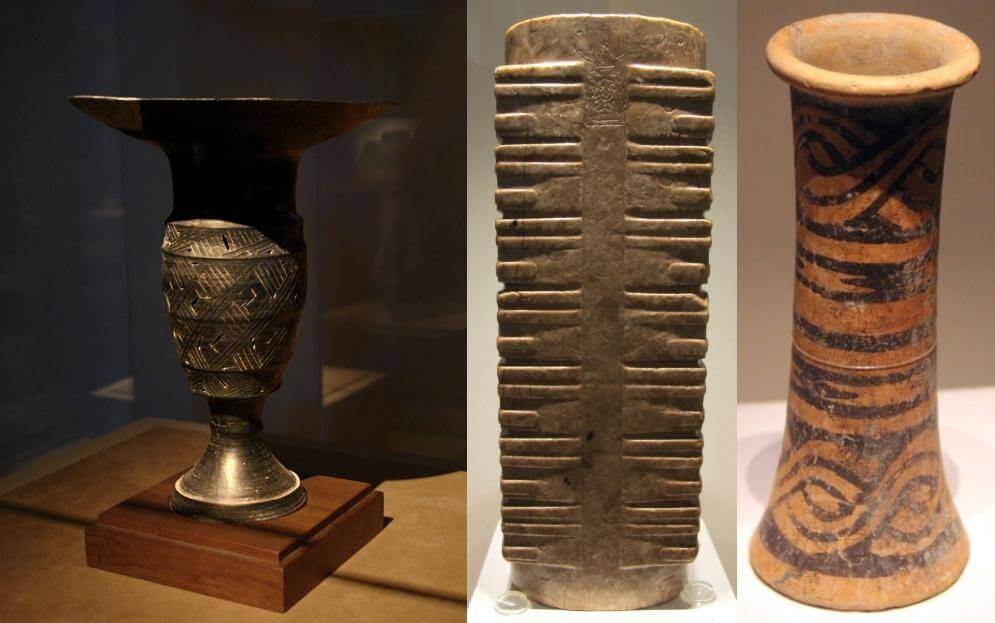 Left: Black Pottery Goblet, Shandong Longshan Culture, Late Neolithic Period (ca. 2500 - 2000 BC) Middle: Liangzhu Jade Cong (a piece of square jade with a round hole) Right: Painted earthenwear cylindrical vase (ping), Daxi culture, Excavated from Daxi in Wushan county, Sichuan province. National Museum of China, Beijing
Left: Black Pottery Goblet, Shandong Longshan Culture, Late Neolithic Period (ca. 2500 - 2000 BC) Middle: Liangzhu Jade Cong (a piece of square jade with a round hole) Right: Painted earthenwear cylindrical vase (ping), Daxi culture, Excavated from Daxi in Wushan county, Sichuan province. National Museum of China, Beijing
The third significant culture that developed during the neolithic period was the Liangzhu culture (3300 BC - 2300 BC). This culture was based in the area around Taihu Lake in the Yangtze River Delta. The ruins of its capital city have been excavated close to the present-day city of Hangzhou. Some historians believe that the population of this ancient city of Liangzhu may have exceeded 30,000 people at its peak. That would have made it the world's largest city during this early time in history.
The strictly-hierarchical Liangzhu society is widely regarded as the earliest state-based society in East Asia. Its monumental water management system was unprecedented in the world at that time. A system of dams, reservoirs, canals and natural river courses protected the ancient city of Liangzhu from flooding and provided the water that was necessary for rice cultivation.
Even though Liangzhu pottery was just as elaborately produced as the pottery of the above-mentioned neolithic cultures, this culture is much better known for its exquisite jadeware. It is also the only prehistoric culture that is known to have worked with sapphire (a.k.a. the mineral corundum). Some researchers believe that the Liangzhu craftsmen must have used diamond tools to polish the corundum ceremonial axes that have been excavated from some tombs. If that was indeed the case, it would constitute the world's earliest known use of diamond tools.
Most Liangzhu jadeware and pottery had symbols engraved on them. These small symbols are considered to be an ancestral system to the Chinese written script by some scholars. The markings are assumed to be identifiers of either the craftsman, owner, clan or tribal group associated with the particular object. This graphic identification system of just one or two characters or symbols per object reappears in later inscriptions and therefore might be considered the earliest form of proto-Chinese writing (if the Damaidi rock carvings were only pictures after all).
The world-famous Liangzhu Site is comprised of the ancient City Site, the Yaoshan Site (an altar and cemetery) and several ancient dams and reservoirs. Since the site's inscription on the UNESCO world heritage list in 2019, more and more tourists have come each year to visit the ruins and admire the unearthed relics at the modern Liangzhu Museum.
Liangzhu Museum & Ancient City
The ruins of the ancient city of Liangzhu are located near Hangzhou (Zhejiang province). A series of hydraulic dams protected this capital city of the Liangzhu culture from flooding. The Archaeological Ruins of Liangzhu City can be seen inside the Yaoshan and the Liangzhu Ancient City Ruins Park. Thousands of ancient relics that were unearthed from these sites are now exhibited at the modern Liangzhu Museum.
Click here to learn more!Opening Hours
Liangzhu Museum: 9am - 5pm
Liangzhu Ancient City Ruins Park: 9am - 5pm
Yaoshan Ruins Park: 9am - 5pm
Entrance Ticket Prices
Liangzhu Museum: Free
Liangzhu Ancient City Ruins Park: 80 yuan
Yaoshan Ruins Park: Free
The Daxi culture (4400 BC - 3300 BC) that emerged in the valleys of Sichuan is less well known than the previously mentioned cultures but some promising discoveries were made in recent times. The culture got its name from the fact that its main archeological site is located near Daxi Village at the eastern exit of Qutang Gorge in Wushan County. In addition to the main Daxi Site, more than ten other Daxi culture sites have been identified in the provinces of Hunan and Hubei.
The Daxi people are presumed to have lived in matriarchal clan communes for the largest part of their culture's existence. This presumption is based on the discovery that the tombs of women generally contained more funerary objects than the tombs of men. Over time, the Daxi culture evolved to become a patrilineal clan society though.
The main Daxi Site was discovered by the Danish-American archaeologist Nels C. Nelson in the 1920s. Multiple excavations of it uncovered 208 ancient tombs and 1,250 ancient cultural relics such as pottery, jadeware, stone objects as well as objects made of bone.
The Daxi Culture pottery that was excavated from the Daxi Site differs from the other types of neolithic pottery that are mentioned above in form, design and decoration. Pottery of various shapes was produced by the Daxi craftsmen such as kettles, pots, jars, basins, bowls and bottles. Most Daxi pottery was red in color but gray and black pottery exists as well and there were even some objects that were gray inside and red outside. Black lines were used to decorate the pottery objects with feather and net designs, rope impressions or horizontal V designs.
Chinese History Digest's summary of China's history continues with the story of the Xia dynasty in the next section. Long thought to be a mere myth, there are more and more signs that seem to prove the existence of this mysterious dynasty of which not much is known so far.
